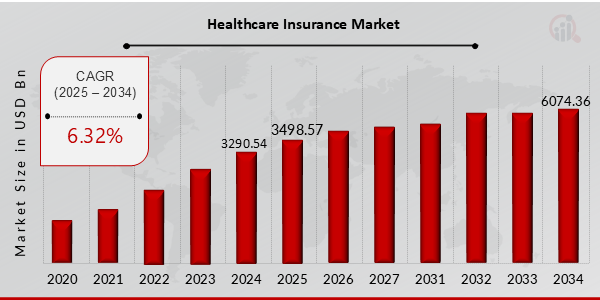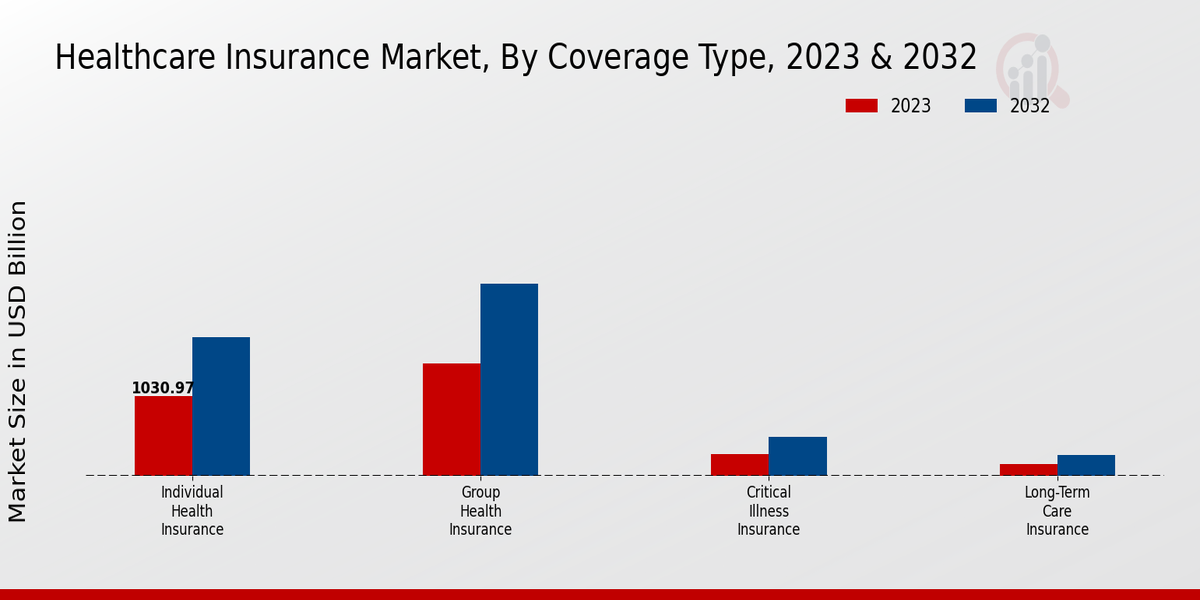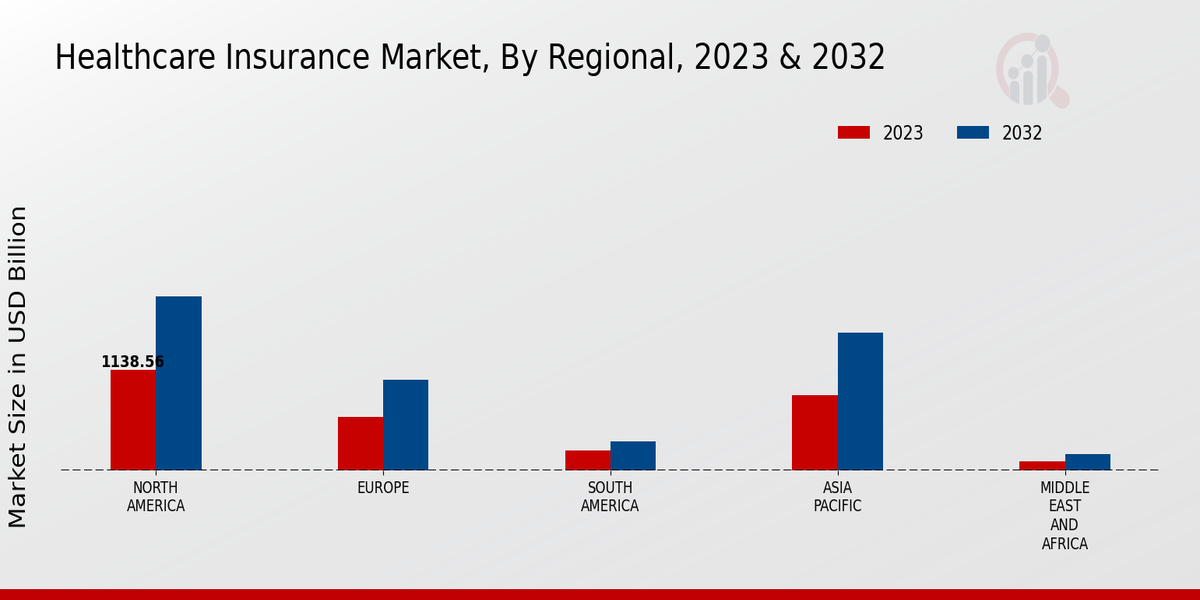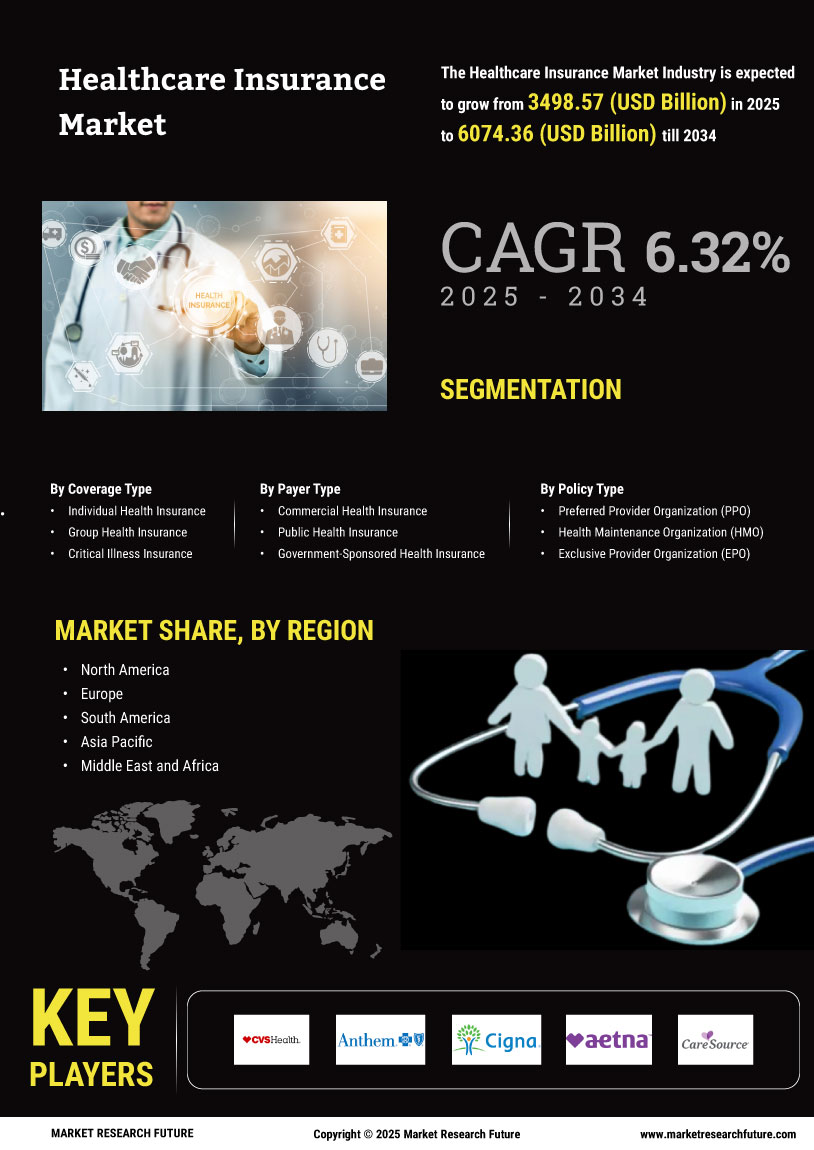Global Healthcare Insurance Market Overview
Healthcare Insurance Market Size was estimated at 3290.54 (USD Billion) in 2024. The Healthcare Insurance Market Industry is expected to grow from 3498.57 (USD Billion) in 2025 to 6074.36 (USD Billion) till 2034, exhibiting a compound annual growth rate (CAGR) of 6.32% during the forecast period (2025 - 2034).

Source Primary Research, Secondary Research, MRFR Database and Analyst Review
Key Healthcare Insurance Market Trends Highlighted
The healthcare insurance market has witnessed some key drivers, such as rising healthcare costs, a better understanding of healthcare benefits, and government attempts to promote the availability of insurance policies. The expansion of telemedicine, personalized insurance plan development, and technology integration to provide a better customer experience are increasing market opportunities.
Value-based care is one recent trend in the Healthcare Insurance market. Additionally, pay-for-performance insurance models, bundled payments becoming established, risk assessment improvement, and underwriting through data analytics have also been observed trends in this sector. Lastly, the outbreak of COVID-19 expedited the adoption of telemedicine as well as remote healthcare services that could drive growth in this segment.
Healthcare Insurance Market Drivers
Rising Healthcare Costs
The upsurge in the costs of healthcare is attributed to one of the major growth drivers in the Healthcare Insurance Market Industry. The increasing cost of health care has resulted in more people seeking insurance to cover medical expenses. This holds especially true for developing countries, where many households are strained by the financial burden of health care. According to a World Health Organization report, expenditure on health is projected to surpass 10 trillion dollars by 2025.
Several factors propel this growth, including rising drug costs, medical devices and hospital care prices. Another reason behind the rise in the Healthcare Insurance Market Industry is the aging population. With population aging comes increased demand for health care services. The fact that old people tend to have chronic diseases that require long-term treatment contributes to this growing demand. On top of this, unhealthy lifestyles and bad nutrition greatly increase the rates of chronic diseases.
In light of understanding how beneficial it is to have a health insurance policy, there will be a greater likelihood that people will buy them, especially in countries where it’s not mandatory.
Government Regulations
Again, the government’s regulations are similarly a big shot in the arm for growth in the Healthcare Insurance Market Industry. Governments in various countries now require people to have health insurance. This is particularly true in developed countries where the cost of medical care may be a huge burden to the government. For example, under Obamacare, all Americans must have health insurance.
The number of people who have health insurance has increased significantly as a result. Moreover, the government forces people to buy healthcare policies by passing laws that help them purchase insurance easily. In developing nations like this, governments provide subsidies that enable individuals to buy health insurance products.
Technological Advancements
The health insurance industry is also experiencing growth due to advancements in technology. First, new technologies are making it easier for people to purchase and manage their health insurance. For example, many insurers now have online portals that allow people to purchase and manage their health insurance policies. This makes it easier for people to purchase health insurance and find the best one for them. Moreover, new technologies also make it easier for insurers to process claims and provide customer service faster and more efficiently, which benefits both insurers and policyholders.
Healthcare Insurance Market Segment Insight
Healthcare Insurance Market Coverage Type Insights
The Healthcare Insurance Market is segmented into Coverage Type, which include Individual Health Insurance, Group Health Insurance, Critical Illness Insurance, and Long-Term Care Insurance. Individual Health Insurance is designed for individuals and families, providing coverage for medical expenses not covered by government programs such as Medicare or Medicaid. The Individual Health Insurance segment accounted for a significant portion of the Healthcare Insurance Market revenue in 2023 and is projected to maintain its dominance throughout the forecast period.This growth is attributed to the increasing number of people seeking private health insurance due to rising healthcare costs and limited access to public programs.
Group Health Insurance is provided by employers to their employees and their dependents. The Group Health Insurance segment is expected to witness steady growth over the forecast period, driven by the rising demand for employer-sponsored health insurance plans. With the increasing cost of healthcare, employers are looking for ways to attract and retain employees, and offering comprehensive health insurance plans is one of the most effective ways to do so.Critical Illness Insurance provides a lump sum payment to policyholders who are diagnosed with a critical illness, such as cancer, heart attack, or stroke. The Critical Illness Insurance segment is expected to experience significant growth in the coming years, driven by the rising incidence of critical illnesses and the increasing awareness of the financial burden they can impose.
Long-Term Care Insurance provides coverage for long-term care expenses, such as nursing home care, assisted living, or home health care. The Long-Term Care Insurance segment is expected to grow at a moderate pace over the forecast period, driven by the aging population and the increasing need for long-term care services.The Healthcare Insurance Market is highly competitive, with a large number of domestic and international players. The major players in the market include UnitedHealth Group, Anthem, Humana, CVS Health, and Kaiser Permanente. The growth of the market is attributed to factors such as the increasing demand for health insurance, the rising cost of healthcare, and the growing awareness of the importance of health insurance.

Source Primary Research, Secondary Research, MRFR Database and Analyst Review
Healthcare Insurance Market Payer Type Insights
The Healthcare Insurance Market segmentation by Payer Type includes Commercial Health Insurance, Public Health Insurance, and Government-Sponsored Health Insurance. Commercial Health Insurance held the largest market share in 2023, accounting for over 54% of the Healthcare Insurance Market revenue. The growth of the commercial health insurance segment can be attributed to the increasing demand for private health insurance plans by individuals and employers. Public Health Insurance is expected to witness a significant growth rate during the forecast period, owing to the rising government initiatives and programs aimed at providing affordable healthcare coverage to the population.Government-Sponsored Health Insurance schemes are projected to grow steadily, driven by the increasing focus on providing healthcare coverage to low-income individuals and families.
Healthcare Insurance Market Policy Type Insights
The Healthcare Insurance Market is segmented by Policy Type into Preferred Provider Organization (PPO), Health Maintenance Organization (HMO), Exclusive Provider Organization (EPO), and Point-of-Service (POS) Plan. Among these, PPO held the largest revenue share in 2023, and it is expected to continue its dominance throughout the forecast period. The increasing popularity of PPOs can be attributed to their flexibility, as they allow policyholders to seek care from any provider, both within and outside of the network, without a referral.
HMOs, on the other hand, have a more restrictive network of providers, but they typically offer lower premiums than PPOs.EPOs are similar to HMOs, but they do not cover out-of-network care at all. POS plans offer a combination of HMO and PPO features, allowing policyholders to choose to stay within the network for lower costs or go outside the network for more flexibility.
Healthcare Insurance Market Benefit Design Insights
The Benefit Design segment plays a crucial role in shaping the Healthcare Insurance Market. High-Deductible Health Plan (HDHP) is a popular choice, offering lower premiums but higher deductibles. Health Savings Account (HSA) allows individuals to save pre-tax dollars for healthcare expenses, further reducing out-of-pocket costs. Flexible Spending Account (FSA) provides tax-advantaged funds for qualified medical expenses. Health Reimbursement Arrangement (HRA) is employer-funded, reimbursing employees for eligible healthcare expenses.
In 2023, the Healthcare Insurance Market revenue for Benefit Design segment was valued at USD 1,256.3 billion and is projected to grow at a CAGR of 6.7% to reach USD 1,735.6 billion by 2032.This growth is attributed to rising healthcare costs, increasing awareness about health insurance, and government initiatives promoting affordable healthcare plans. The segment offers flexibility and cost-saving options, making it an attractive choice for both individuals and employers.
Healthcare Insurance Market Channel Insights
The Healthcare Insurance Market segmentation by Channel comprises Direct-to-Consumer, Brokers and Agents, Online Marketplaces, and Employer-Sponsored Plans. Among these, Brokers and Agents captured the largest market share in 2023, owing to their expertise in providing personalized advice and assisting customers in selecting the most appropriate insurance plans. However, Online Marketplaces are projected to witness the highest CAGR during the forecast period, driven by the increasing adoption of digital platforms for insurance purchases. The growing popularity of Direct-to-Consumer channels is also notable, as consumers seek greater control over their insurance choices.Employer-Sponsored Plans continue to play a significant role, particularly in countries with established healthcare systems.
Healthcare Insurance Market Regional Insights
The Healthcare Insurance Market is segmented into regions such as North America, Europe, APAC, South America, and MEA. In 2023, North America dominated the market with a revenue of 1454.61 (USD Billion), followed by Europe with a revenue of 765.21 (USD Billion). The APAC region is anticipated to exhibit significant growth during the forecast period, registering a CAGR of 7.5% to reach a value of 1437.76 (USD Billion) by 2032. This growth can be attributed to the increasing prevalence of chronic diseases, rising healthcare costs, and growing awareness about health insurance among the population.South America and MEA are also expected to contribute to the overall market growth, albeit at a slower pace.

Source Primary Research, Secondary Research, MRFR Database and Analyst Review
Healthcare Insurance Market Key Players And Competitive Insights
Major players in the Healthcare Insurance Market industry are constantly striving to gain a competitive edge by offering innovative products and services, expanding their geographic reach, and forming strategic partnerships. Leading Healthcare Insurance Market players are investing heavily in technology and digitalization to improve customer experience, streamline operations, and reduce costs. The Healthcare Insurance Market industry is characterized by intense competition, with major players vying for market share through various strategies such as product differentiation, pricing strategies, and customer service initiatives. Healthcare Insurance Market development is driven by factors such as rising healthcare costs, increasing awareness of health insurance benefits, and government regulations mandating health insurance coverage.
United Health Group Inc. is a leading player in the healthcare insurance market. The company offers a wide range of health insurance products and services, including employer-sponsored health insurance, individual health insurance, and Medicare and Medicaid coverage. UnitedHealth Group Inc. has a strong presence in the United States and is expanding its operations internationally. The company's focus on innovation, customer service, and cost containment has contributed to its success in the healthcare insurance market.Cigna Corporation is another major player in the healthcare insurance market.
The company offers a comprehensive portfolio of health insurance products and services, including health maintenance organizations (HMOs), preferred provider organizations (PPOs), and point-of-service (POS) plans. Cigna Corporation has a significant presence in the United States and is also expanding its operations internationally. The company's commitment to providing affordable, high-quality health insurance has made it a popular choice for consumers and employers alike.
Key Companies in the Healthcare Insurance Market Include
- CVS Health
- Anthem
- Cigna
- Aetna
- Ambetter from WellCare
- CareSource
- Humana
- Molina Healthcare
- Elevance Health
- Oscar Health
- Clover Health Investments
- Centene Corporation
- Kaiser Permanente
- UnitedHealth Group
- Bright Health Group
Healthcare Insurance Market Industry Developments
The healthcare insurance market size is expected to reach USD 5,054.0 billion by 2032, exhibiting a CAGR of 6.32% during the forecast period. The increasing prevalence of chronic diseases, rising healthcare costs, and growing awareness of the importance of health insurance are major factors driving the market growth.The COVID-19 pandemic has had a significant impact on the healthcare insurance industry. The demand for health insurance has increased as people become more aware of the importance of financial protection against unexpected medical expenses.
Additionally, the pandemic has accelerated the adoption of telemedicine and other digital health services, which are expected to continue to drive market growth in the coming years.Key market players are focusing on strategic collaborations, acquisitions, and product innovations to strengthen their market position. For instance, in May 2023, Cigna Corporation and Express Scripts Holding Company announced a definitive agreement to combine their businesses to create a leading health services company. The combined company will have a broad portfolio of products and services, including health insurance, pharmacy benefit management, and care coordination.
Healthcare Insurance Market Segmentation Insights
-
Healthcare Insurance Market Coverage Type Outlook
- Individual Health Insurance
- Group Health Insurance
- Critical Illness Insurance
- Long-Term Care Insurance
-
Healthcare Insurance Market Payer Type Outlook
- Commercial Health Insurance
- Public Health Insurance
- Government-Sponsored Health Insurance
-
Healthcare Insurance Market Policy Type Outlook
- Preferred Provider Organization (PPO)
- Health Maintenance Organization (HMO)
- Exclusive Provider Organization (EPO)
- Point-of-Service (POS) Plan
-
Healthcare Insurance Market Benefit Design Outlook
- High-Deductible Health Plan (HDHP)
- Health Savings Account (HSA)
- Flexible Spending Account (FSA)
- Health Reimbursement Arrangement (HRA)
-
Healthcare Insurance Market Channel Outlook
- Direct-to-Consumer
- Brokers and Agents
- Online Marketplaces
- Employer-Sponsored Plans
-
Healthcare Insurance Market Regional Outlook
- North America
- Europe
- South America
- Asia Pacific
- Middle East and Africa
|
Report Attribute/Metric
|
Details
|
|
Market Size 2024
|
USD 3290.54 Billion
|
|
Market Size 2025
|
USD 3498.57 Billion
|
|
Market Size 2034
|
USD 6074.36 Billion
|
|
Compound Annual Growth Rate (CAGR)
|
6.32% (2025-2034)
|
|
Base Year
|
2024
|
|
Market Forecast Period
|
2025-2034
|
|
Historical Data
|
2020-2023
|
| Market Forecast Units |
USD Billion |
| Key Companies Profiled |
CVS Health, Anthem, Cigna, Aetna, Ambetter from WellCare, CareSource, Humana, Molina Healthcare, Elevance Health, Oscar Health, Clover Health Investments, Centene Corporation, Kaiser Permanente, UnitedHealth Group, Bright Health Group |
| Segments Covered |
Coverage Type, Payer Type, Policy Type, Benefit Design, Channel, Regional |
| Key Market Opportunities |
Telemedicine and Virtual Care AIPowered Diagnosis and Treatment Remote Patient Monitoring ValueBased Care Models Personalized Insurance Plans |
| Key Market Dynamics |
Rising Prevalence of Chronic Diseases Technological Advancements Increasing Demand for Comprehensive Coverage Government Regulations Consumer Preference for ValueBased Care |
| Countries Covered |
North America, Europe, APAC, South America, MEA |
Frequently Asked Questions (FAQ) :
The Healthcare Insurance Market size is estimated to be worth around USD 3290.54 billion in 2024 and is projected to expand at a compound annual growth rate (CAGR) of 6.32% from 2025 to 2034, reaching approximately USD 6074.36 billion by 2034.
North America currently dominates the healthcare insurance market, accounting for a significant share of the market revenue. The region's well-established healthcare infrastructure, high healthcare expenditure, and increasing prevalence of chronic diseases contribute to its leading position.
The growth of the healthcare insurance market is primarily driven by several factors, including the rising healthcare costs, increasing demand for health insurance coverage, growing awareness of health insurance benefits, expanding government initiatives to provide health insurance, and technological advancements in the healthcare sector.
Some of the prominent players in the healthcare insurance market include UnitedHealth Group, Anthem, Inc., CVS Health, Humana Inc., Cigna Corporation, Kaiser Permanente, Aetna Inc., Centene Corporation, and Ping An Insurance (Group) Company of China, Ltd.
Healthcare insurance finds applications in various sectors, including individual health insurance, group health insurance, dental insurance, vision insurance, long-term care insurance, and travel health insurance.
The healthcare insurance market faces challenges such as rising healthcare costs, increasing regulatory compliance requirements, data privacy and security concerns, and the emergence of new technologies that disrupt traditional healthcare insurance models.
Key trends shaping the healthcare insurance market include the adoption of value-based care models, the use of artificial intelligence (AI) and machine learning (ML) in underwriting and claims processing, the growing popularity of telemedicine, and the increasing focus on preventive healthcare.
The COVID-19 pandemic has had a significant impact on the healthcare insurance market. The pandemic has led to an increase in the demand for health insurance coverage, as individuals and businesses seek to protect themselves against the financial risks associated with healthcare expenses. Additionally, the pandemic has accelerated the adoption of digital health technologies, such as telemedicine and virtual care, which are expected to continue to shape the market in the post-pandemic period.
The future of the healthcare insurance market is expected to be driven by the increasing demand for health insurance coverage, the rising adoption of digital health technologies, and the growing focus on preventive healthcare. The market is expected to continue to grow steadily in the coming years, with a focus on providing affordable and accessible health insurance solutions to individuals and businesses around the world.
The healthcare insurance market is subject to various regulatory considerations, including those related to solvency, capital adequacy, and consumer protection. These regulations vary from country to country, and it is important for healthcare insurance providers to be aware of the specific regulatory requirements in each jurisdiction in which they operate.

















